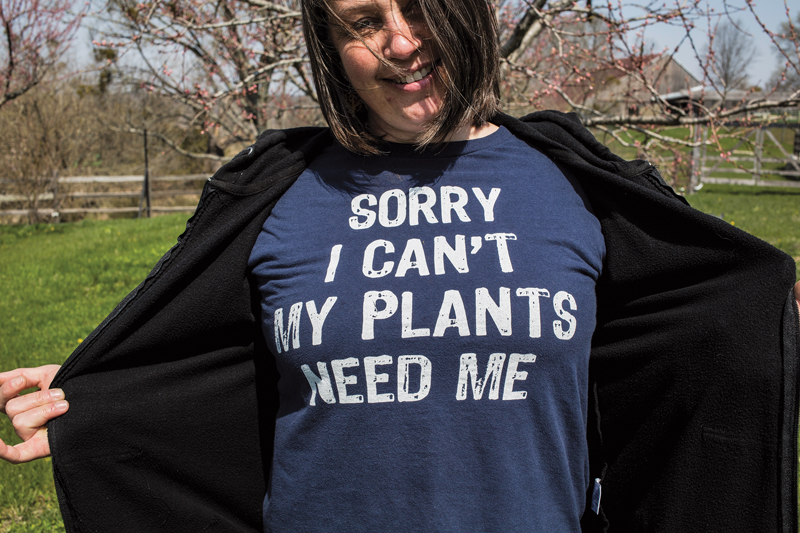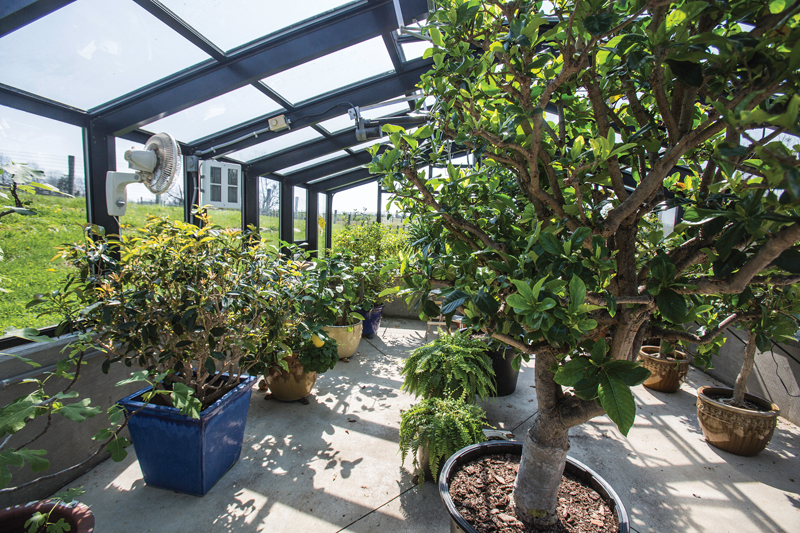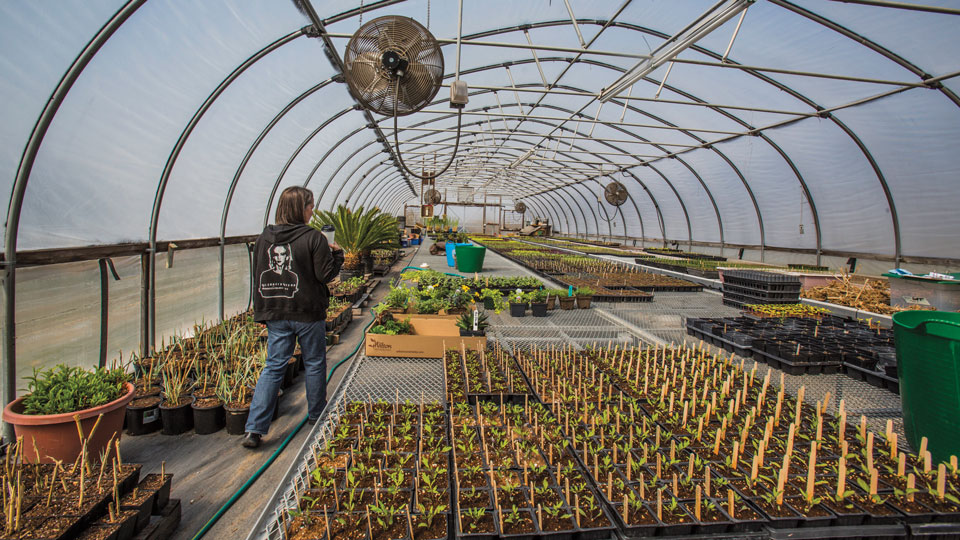Photos by Mickie Winters
Stephanie Tittle’s Subaru Outback with 180,000 miles on it is in the shop, so today’s stand-in is a Jeep Renegade. A 77-pound Great Pyrenees named Eloise snores in the back, and the tires disturb the gravel roads as Tittle winds through the 1,000-acre farm in Goshen. On this early April morning the sky is spitting snow (the previous day: sunny and 77). At Woodland Farm, the home of 21c owners Steve Wilson and Laura Lee Brown that’s also a bison, hog, chicken and cow farm, farm store and sculpture display (surely you’ve seen photos of those giant hot-pink snails), Tittle does all things horticulture. Yellow forsythia shrubs decorate the outside of a horse barn. Wisteria tries to escape an arbor that’s the entryway to a garden with rows of strawberry leaves and pots of mint between limestone walks and walls. “I’m not really a big perennial girl,” Tittle says, “which is all the things that people mostly get excited about — the tulips, pansies, daisies. I’m more interested in things that are gonna be for the next generation.”

We get out to walk around the farm and up trots Eloise’s brother, 127-pound Ferdinand, whose white coat is more of a faded pink from a Kool-Aid dye job in celebration of Wilson’s 70th birthday. The three-story brick house, which dates to 1814, looks out over a bend in the Ohio River. Brown and Wilson bought the farm in 1996 when it was slated to become a golfing community. They wanted to protect the land with something more sustainable, so they decided to raise bison.
Brown hired Tittle 11 years ago to maintain perennial beds and maybe grow some vegetables for the kitchen. From there, Tittle says, it “exploded” to a 365-day-a-year operation, and she now has a five-person crew working under her. (She also beautifies the horse-driving course at Brown and Wilson’s Hermitage Farm, also in Goshen but closer toward town off Highway 42.) An orchard features peach, cherry, apple and plum trees, which Tittle and the crew prune in cooler months. Tittle says that as the winter has gotten shorter, that she has harvested vegetables well into December. “I can tell you when spring is here, whether you believe it or not, because I’m the first person to see that bulb barely press its head through the soil,” she says. Inside the smaller of the two greenhouses are two potted gardenias that once belonged to Brown’s aunt and are “older than I am,” says Tittle, 46. (They’re actually 35.) She will move them and other potted treasures to the terrace by the house once the low temperatures are steadily above 40 degrees. “But if it’s the day before Derby, they’ll go out there,” she says. “It’s one or the other.”
Tittle grew up in Pewee Valley. Her parents worked a lot, so her plant-loving grandfather watched over her. “We spent all of our time outside foraging for wild things and I was mostly just…dirty,” she says with a drawl. She studied horticulture and worked in various nurseries and greenhouses before she got the Woodland position.
With shoulder-length brown hair and glacier-blue eyes, Tittle moves through the farm with an air of authority. Ear-numbing gusts of wind cause her to speak a little louder. She hasn’t got a coat on, just jeans and some layered shirts. Her teeth chatter from the cold. But she doesn’t seem to care — she’s always in motion, in and out of greenhouses and other buildings. She trudges up a hill to check a rain gauge. “We’ve had such an intense amount of rain this year,” she says. “It’s not normal. I don’t know what normal is anymore.” She’s a methodical chronicler, having mapped every area of the farm that’s under her supervision, because she wouldn’t want to plant over anything that’s hibernating underground. Once a week, she photographs plants to compare to previous years. She’ll do some of her own plumbing and pruning — as long as her feet are on the ground. Otherwise, she’ll contract out jobs. “I don’t want to put fellas in a bad place,” she says, “and some of them respect me and treat me as their equal — but many of them ‘honey’ me and sort of mansplain to me and I won’t hire them.”
 |
In the larger greenhouse, two young women cut leaves of baby salad greens — lettuce, spinach, broccoli, collards, kale. “Can I ask you all to be skinny?” Tittle says to them as she cranks a handle and shifts the table to the right, narrowing the space between them and another table, barely enough to fit a Victorian-era waistline. We walk though the aisle she’s now created and inspect a heat bench that she built for starting seeds. Tubes run across pink insulation — pink because the cheaper blue version would have attracted thrips, which feed on the leaves. Tittle never uses pesticides but will deploy other methods, such as introducing parasitic wasps. Sometimes her crew will hand-pick bugs off leaves. Okra and zinnias begin their lives on this bed, in three different heat zones. More potted plants cozy up in the greenhouse, including dahlias and a sago palm, one of Wilson’s favorites. They’re ready to go in the ground but it’s too wet to dig. In one of the corners is a birdhouse-looking contraption with a window, door and chute. It’s a dehydrator that the carpentry crew built. Sunlight hits it and warm air climbs up to dry out the shelves of peppers that shrivel up inside. “We created this in my skull and built it,” Tittle says. “The only limit here is your own mind.”
Does Tittle ever take a day off? She laughs. She took off five days to go to Maine in 2008. “This is a really nice place to work,” she says. She’ll leave for two weeks this summer to go to Japan (her husband is going for work and she didn’t want to miss the opportunity), where she’ll immerse herself in gardens and come back inspired.

Stephanie Tittle, horticulturist at Woodland Farm.
She’ll often sit at the kitchen table while Brown eats breakfast and they’ll go through catalogs and come up with ideas. The day before I meet with Tittle, she and Brown stole some rare free time and drove through Cave Hill Cemetery and neighborhoods as they made their way back, looking at trees and flowers for inspiration. “I really like conifers a lot and weird grafted material, and she’s not really interested in that,” Tittle says, “so I keep going, ‘Look at that Japanese white pine,’ and she always says, ‘That doesn’t do anything for me.’”
This spring, Tittle is prepping for the Glenview Garden Club tour on May 11 and 12, which will feature six area gardens, including Woodland. Tittle says her gardens should always be tour-ready. The heavy rain has kept some projects from advancing, as evident in the clumps of dirt that isn’t yet flower beds, adjacent to a pond.
 |
We get back in the Jeep, and Tittle says that people who think they don’t have a green thumb probably over-manage their plants. “I don’t like to prune things to be in shapes that are not natural,” she says. “I like to let the plant material be what it wants to be.” She pauses for a few moments and stares out the window. “That’s kind of zen.”
When we drive through a forested area with winter’s dead leaves and fallen branches covering most of the ground, I wouldn’t think this would be Tittle’s territory, as there’s also a farm manager for non-horticulture areas, but she’s on the hunt for a trout-lily bloom. She saw one the other day, but they’re ephemerals that only flower for hours, rather than days or months like some plants. Her crew will harvest wild plants, such as watercress and ramps, for dinners that Brown and Wilson host. Casting a keen eye on what to me looks like a pile of winter brush, Tittle says, “There are plants that I know what they look like but have never in my life seen flower in person. Like, jack-in-the-pulpit grows native in Kentucky. I’ve never seen one in the wild. It’s like my life’s goal to actually see one.” We get back in the car and head toward the top of the road near the farm’s main entrance. She points out the window at mayapples, floppy mushroom-looking green leaves sprouting from the earth. “My grandfather used to tell me that’s where fairies hang their dresses when they take a nap and that you have to be very quiet when you go near. The flower looks like a little fairy dress on a hanger, so I believed all the fairies were taking naps.” She slams on the brakes. “Oh, I see it! That tiny thing there is a trout-lily bloom! They’re the cutest thing in the world.” We get out to see the thumb-sized yellow form, drooping downward like it’s sad its death is near.
“The rest of the world misses this,” Tittle says.
This originally appeared in the May 2018 issue of Louisville Magazine on pg. 78 under the headline Farm Girl. To subscribe to Louisville Magazine, click here. To find us on newsstands, click here.



